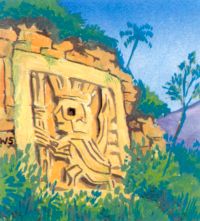| adventure games |
In the second and final part of his series on adventure games, Phil Garrett comes to grips with Inca temples, catacombs and nasty mountains.
ARTIC Computing advertises three Adventures, with the rather uninspired titles of A, B and C. They are written in machine code and seem to be from the same original master program, so we can probably expect more adventures in the future.
Adventure A appears to be 12½K long but on closer inspection a fair amount of this seems to be empty. It has about 20 locations, a similar number of objects, and along with the other Artic games, a large vocabulary of more than 100 words.
The setting is an alien planet which you are trying to leave, and there is a green man to deal with, a spaceship to find, and even a computer - they get everywhere. Unlike the other two games, you cannot save your present position to return later.

Adventure B is set in an Inca temple, is 11K long and is the only one of the three to give you a score. For what it is worth, mine never went above zero. This game has 50 locations with short descriptions and more than 25 objects, not including the treasures, which, as in all the Artic games, need to be used at the proper time and in the proper combination to be useful.
I had some problems with this game. It was sometimes very strict about the word required at a certain point; for example you cannot go "Up" the stairs, they must be "Climbed".
The 13K Adventure C is the largest of the three and is set on an alien spaceship. The object is to press a control button somewhere which will release your own ship from the fiendish Gravitron Beam and allow you to escape.
The program contains more than 35 locations and 40 objects, and is, I think, on two levels separated by a hidden door. Despite having spent hours exploring, and manipulating objects on the first level, I still have not been able to break through.
Having cheated furiously I know that, apart from the control button, the other level contains more rooms and objects, and a distinctly X-rated Android I would like to meet.
All three programs respond to "Help", although rarely helpfully, and "R" repeats the room description. Despite the large vocabulary, the response time is, to all intents and purposes, instantaneous, which makes a difficult and frustrating adventure easier to hear.All the programs use the Artic keyboard scanning routine, which means that there is no response to the break key. The only way I have found to stop the programs, so that I could make a security copy, is by entering three or four "Newlines" and then a complete line of letters which overloads the display file and stops the program with a "5" error.
Having done this, I discovered that the instructions for Adventure C got the name of the program wrong. The filename is ADVENT C not ADVENT as stated.
At £5, £7 and £7 for A, B and C respectively, they are all good value, and will take many, many hours to master.
Catacombs from J K Greye is an all-graphics-real time game. There is no chance of having a think about where to go next on this one, as your strength steadily drops whether or not you are doing anything.
As you move around using the standard cursor controls, the surrounding area is revealed. Each level of the catacombs is made up of a random set of inter-connected rooms containing random amounts of food, F, gold, £, and monsters, O for Ore, D for Dragon. Depending on your strength you can either fight the monsters or run away and, if necessary, you can even tunnel through the walls.
The program is written in 9½K Basic and 2K of machine code. Despite the machine code, the game takes more than two minutes to set up. Something else to watch for is the Exit, X. If you go through it you have a two-minute wait for the next level to be set up.
This is a nicely-done graphics game with your strength and score, the amount of gold you have amassed, shown on-screen. At £5.95 it is a little expensive and would be greatly improved if the setting-up could be converted to machine code, since beginners may find the setting-up takes longer than the game.

I have to admit that Giltrole's Nasty Mountain nearly had me beaten. After playing the game, studying the listing, and cheating furiously, I finally managed to get out with a score rated as "awful".
The idea is to cross a mountain via a set of seven logically-connected caves. Your tortuous path from one cave to the next is shown graphically, and the caves may contain objects, mainly edible, such as apples and carrots. The nasties are not all that fearsome, being rabbits and chickens, but they have to be treated the proper way if you want to get anywhere.
The program is written in 12K of Basic and runs at a gentle pace. Movement and picking-up objects can be done with whole words or abbreviations if preferred, but you are told your score only if you manage to get out. You can enter 'Help' if you get stuck but all that happens is that the program determines whether or not it is still possible for you to escape, which is scarcely helpful.
This is a well-presented logical adventure, and £4.95 is a fair price.
Philip Joy's non-graphics Cathedral Adventure is written in 15K of Basic and describes more parts of a cathedral than I ever knew existed - more than 30 in fact. Shortish descriptions are given, sometimes including a cryptic clue - no pun intended - and more than 70 words are recognised, although the input processing routine can be slow, sometimes nearly 30 seconds.
Some of the treasures which are scattered around may be required later in the adventure, although I have not yet got past the Mad Monk to find out.
Plenty of invention has been used in working-up the locations, and some of the spelling, too, in this game, which costs £7.50.
Psion offers a tape with two sci-fi adventure-style games, written in 9K and 14K of Basic. The task facing the intrepid adventurer in Perilous Swamp is to rescue a princess and return safely, having fought, or bribed, monsters at every turn. You are given a map to help you and a new layout is produced for each game.
The monsters, their strength, and the amount of treasure they are guarding are generated randomly at each step; you have to decide how much strength to use in overcoming them, or how much to offer as a bribe.
This program is really a fairly simple guessing game rather than an adventure; there are no objects and no special locations but it has been well done, and was a welcome relief from some of the more brain-taxing games.
| 'What is so good about a computer is that it is limited only by our own imagination. With each new program you can load an entire new world' |
The second Psion program, Sorcerers Island is a cross between the first and more traditional adventures. The detailed map is the same for each game and takes nearly a minute to display. There is a small vocabulary, move, fight, and so on entered as single letters, some objects, and even a rather ponderous maze. As you try to find the way off the island you use up your Life Points and hope to increase your Treasure Points.
In the process of reviewing these adventures I have been attacked by snakes and spiders, pirates and prawns, rats and rabbits, dragons and dwarfs, and countless more terrors of the imagination but it was worth it when the puzzle set by the writers of the programs was finally cracked.
What is so good about a computer is that it is limited only by our own imagination. With each new program, you can load up entire new world.